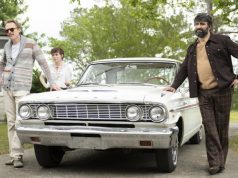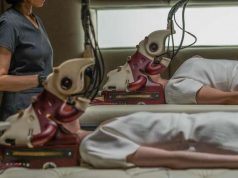Dennis Gray was born in 1948, joined the Catholic priesthood at around the usual age, and got a job teaching religion at Central Catholic High School in Toledo, Ohio, in the 1970s. At some point during all that, he started molesting boys.
I have omitted the word “allegedly” because there is no reason for it. Yes, the Toledo diocese paid settlements to the victims rather than go to court; yes, during his deposition Gray refused to answer certain questions rather than admit anything. So yes, in legal terms, Gray remains only an “alleged” abuser, not an admitted one or a convicted one. But “Twist of Faith,” a documentary focusing on one of Gray’s young victims 20 years later, makes the facts clear. Dennis Gray is a monster.
Most of the film takes place in 2002 and 2003 in the Toledo area, when Tony Comes is a firefighter in his early 30s with a pretty wife named Wendy and two young children, Samantha and Mitchel. In June 2002, the Comeses move to a new house on a quiet street, only to discover that Dennis Gray — the priest who molested Tony repeatedly when he was in his early teens — lives five doors down. He’s been struggling with the memories all his life, and he and Wendy candidly report on the difficulties they have had because of Tony’s childhood trauma. But now they decide something must be done.
The movie follows Tony’s quest for justice, giving us the events as they unfold, rather than telling us everything through after-the-fact interviews. Tony is not interested in a settlement, which the Catholic Church has been giving out like Halloween candy. He knows the statute of limitations has run out on Gray’s crimes, so all he wants now is a public apology from Gray and the church. He wants people to know what happened. Doling out hush money doesn’t solve the problem, he says, but bringing the problem to light will at least be a step in the right direction.
Tony explains that when he was a boy, Father Denny was everyone’s favorite “cool” priest, often inviting the kids in Tony’s group to stay overnight at his cabin on the lake. You felt thrilled to be part of the in crowd, excited that Father Denny liked you enough to include you in the excursions, where drinking and smoking were allowed. “What happens at the cabin stays at the cabin” was the unspoken rule.
It was there that Gray first began molesting Tony, and it resulted in such stomach-churning ironies as Gray forcing himself upon Tony early on a Sunday morning, and an hour later saying Mass and administering communion to parishioners. Ashamed and afraid, Tony did not try to stop it.
Now, 20 years later, a Minneapolis attorney who specializes in this sort of thing is called in to assist Tony in his petitions against the Catholic Church, and to help with a few other victims who have come forward. That last fact is a slap in the face to Tony, who had been assured by Father James Hoffman that Tony was Gray’s only victim. Now Tony feels guilty for not speaking up as soon as it happened, to prevent Gray from molesting anyone else.
This is heartbreaking stuff, sensitively captured by Kirby Dick, the insightful and brilliant documentarian behind “Chain Camera” and “Derrida.” He uses the same technique that made “Chain Camera” so compelling: He occasionally gives cameras to Tony and Wendy so they can record their own lives, thoughts, and confessions. There’s only so much that even a good documentarian can do to make his subjects feel natural around him, after all.
Dick’s method acknowledges that limitation (and Jacques Derrida pointed it out to him when Dick made a film about him), and it is fascinating to see how much more open and relaxed Tony and Wendy are when there are no interviewers, cameramen or film crews hovering over them. For example, I doubt Wendy would admit to another person that she sometimes feels resentful over how emotionally needy Tony’s past has made him, but she’ll admit it to an un-judging camera. Witness also the tearful scene in which Tony and Wendy explain in basic terms to their daughter what happened to Tony years ago, and caution her never to speak to the man who lives five houses down.
Tony’s faith has been obliterated, and he remains bitter toward the church. He takes some of it out on his mother, who is still a practicing Catholic, saying the money she puts on the collection plate “pays the lawyers that are fighting me.” For her part, she stands firm, maintaining that there is a separation between her faith in the doctrines of the Catholic Church and the actions of certain specific Catholics.
It’s devastating to watch Tony break down, so consumed by anger that he is unable to eat or sleep, his marriage falling apart around him. As sympathetic as we are for him — the fact that he blames himself for Gray’s subsequent victims just twists the knife in the viewer’s gut — we are removed enough from the situation to see that too much anger is useless. There is being righteously indignant in order to fight for what’s right, and then there is plain old hate, which helps no one.
Like most documentaries, “Twist of Faith” lives or dies by its subject matter, and this story is a two-edged sword. The basic concept is extremely compelling, of course, but Dick began filming without knowing how it would all play out, and the end is not as satisfying as you want it to be.
But listen to what Dennis Gray — who left the priesthood in 1987 but continued to teach at public high schools for many years thereafter — says in his videotaped deposition from 2003. Asked whether he thought sex with a priest would do lasting psychological harm to a child, he says no, not necessarily. Later, he says he doesn’t believe in hell. I say he’d better start.
B+ (1 hr., 26 min.; )





